I’ve been saying I want to do shorter pieces for the Sunday feature, and I’m putting that into practice this week. I stumbled across some photos online that were taken by a visiting photographer from Germany, Hans Joachim Jacobi, using an Exakta Varex IIa, an East-German camera. He was visiting Halifax, NS to visit relatives, and stopped off in NYC for a few days. What I’ll do is present them and try to drill down the details as much as possible in a Forgotten NY style. Vanishing NY had the same idea in 2013, but I have different photos.
1971 is a distant time now. It’s the year I graduated grade school, St. Anselm in Brooklyn. The Pittsburgh Pirates beat the Baltimore Orioles, who were in the World Series for the 3rd straight year; the next year, the Oakland A’s would begin a run of 3 straight Series, which they would three-peat. Richard Nixon was preparing to run for a second term. John Lindsay was amid his second term as NYC mayor. Audiences were chortling to the wit and wisdom of Archie Bunker, as All in the Family grabbed the top TV ratings spot in 1971-1972, an era when My Three Sons and The Brady Bunch were going strong (what would a crossover plot involving the characters of those three shows been like?). The top grossing movies? A Clockwork Orange and Willy Wonka & The Chocolate Factory, which no doubt had different audiences.
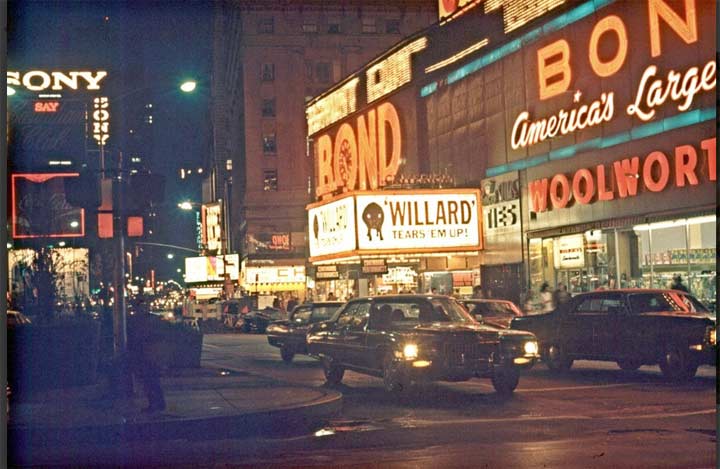
Willard, in which a maniac controls an army of rats to do his bidding and kill his enemies, was tearing up box office lists. In 1971 it was playing in the Criterion Theatre, which had opened back in 1936 at 1514 Broadway between West 44th and 45th Street. Beginning in 1956, the Criterion hosted the world premieres of the Ten Commandments, South Pacific, and My Fair Lady, and the USA debut of Lawrence of Arabia. The Criterion became a multiplex in 1980 and closed in 2000.
Charles Anson Bond founded a haberdashery in Cleveland in 1914, and ten years later operated 28 stores around the country. Though its NYC flagship was at 5th Avenue and 35th Street, by 1940 it had a block-long space in Times Square on Broadway between West 44th and 45th, featuring enormous sculptures and neon signs on its exterior. Bond closed its Times Square store in 1977 and the space became Bonds International Casino for a few years after that. In May and June 1981, The Clash played 17 dates at Bonds. I attended one–great show, but the space was non-air conditioned in June!
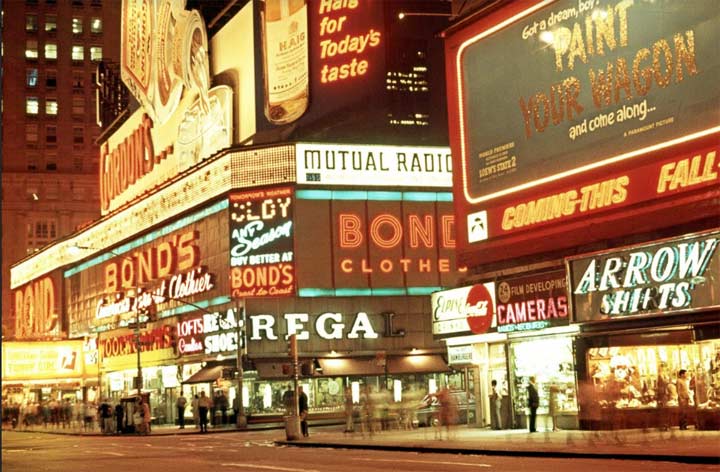
A view of Bond’s from West 44th. Plenty of well-known brand names rented space on the ground floor including F.W. Woolworth 5 and dime; Loft’s Candies, a 1960s NYC staple since the 1920s–it later merged with Barricini and closed its NYC outlets by 1994; Regal Shoes, once ubiquitous but since disappeared.
On the corner is the Elpine Drinks stand, where the fruit juice came in cone-shaped cups in metal holders. In 1957, Tony Curtis plotted his next scheme as press agent Sidney Falco in Sweet Smell of Success there. Finally, Arrow Shirts, a brand of Cluett-Peabody, which manufactured shirts and shirt collars (before the 1920s, shirts and collars were separate) in Troy, New York. My mother and grandmother worked in the Cluett-Peabody offices in the 1940s and 1950s. Phillips-Van Heusen acquired the company in 2004.
Gordon’s Gin had an enormous ad on the Bond’s roof. The company was founded by Scot-Britisher Alexander Gordon in 1769, and the brand is going strong today. Mutual Radio was part of the Mutual Broadcasting System, a commercial radio network in business from 1934 to 1999.
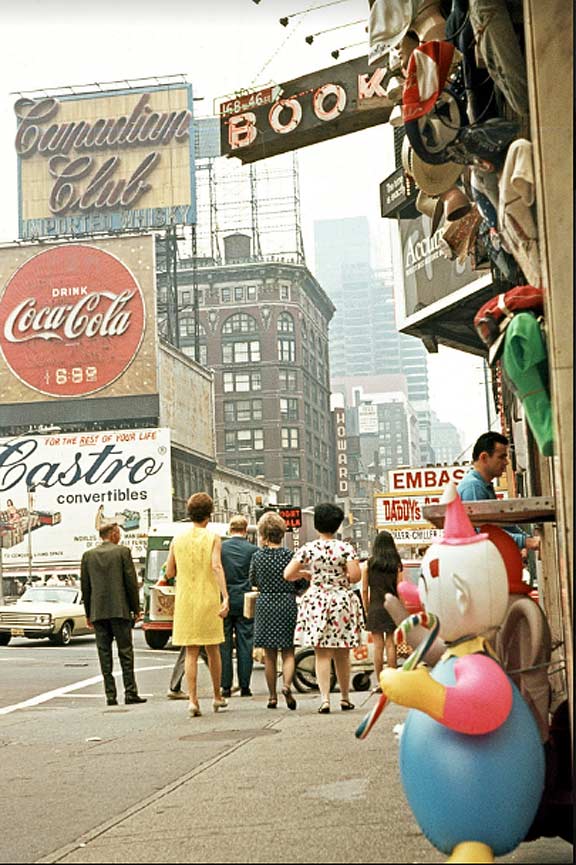
I think we’re looking north on 7th Avenue between West 46th and 47th here. Castro Convertible, which had the most memorable radio jingle in history, Coca Cola and Canadian Club Whisk(e)y, founded by Hiram Walker in Detroit in 1858 but produced for most of its history north of the border, were Times Square neon staples for decades.
In the right foreground is the old Embassy Theatre, a French salon-styled 556-seat one-screener, opened in 1925 by Loew’s. In 1929 it made the unusual move of showing nothing but newsreels which made it the CNN of its era decades before there were all-news/opinion TV stations. Its interior has been designated by the Landmarks Preservation Commission, which has saved it from being altered even after the theatre closed in 1997 and it served as the Times Square Visitors Center from 1998-2014. Among the current tenants is Actors’ Equity, a labor union hall where actors audition for Broadway theater productions.
In 1970, the Embassy was showing Daddy’s Gone a-Hunting, starring Paul Burke and Carol White, in which “a mentally disturbed man stalks a woman who had once aborted the child he had fathered” according to imdb.com. There are a lot of films from the 1965-1985 period that have utterly vanished, except perhaps on DVD, VHS, youtube or Amazon Prime; Turner Classic Movies concentrates on films from 1930-1960, with some newer stuff thrown in.
You can barely see it but just behind the Embassy you can make out the Palace Theatre marquee. The Palace, which is still in business at 1564 Broadway at West 47th, was founded as a vaudeville theater in 1913 by Martin Beck and was once the most desired booking in the country for vaudeville artists. Even after movies entered the bill in 1929, it remained a premier vaudeville theater with Jerry Lewis, Frank Sinatra and Danny Kaye hitting the boards. Among its movie premieres was Orson Welles’ Citizen Kane in 1941. In recent years, it continues as one of the few “Broadway theaters” that is actually on Broadway. The Palace is currently on hiatus for repairs until 2021.
Just about everything else in the picture has disappeared or has been altered beyond recognition. The women’s outfits here are typical for 1970-1971 and about match what my mother was wearing at the time. A billboard for Howard Clothes can be seen further up 7th Avenue.
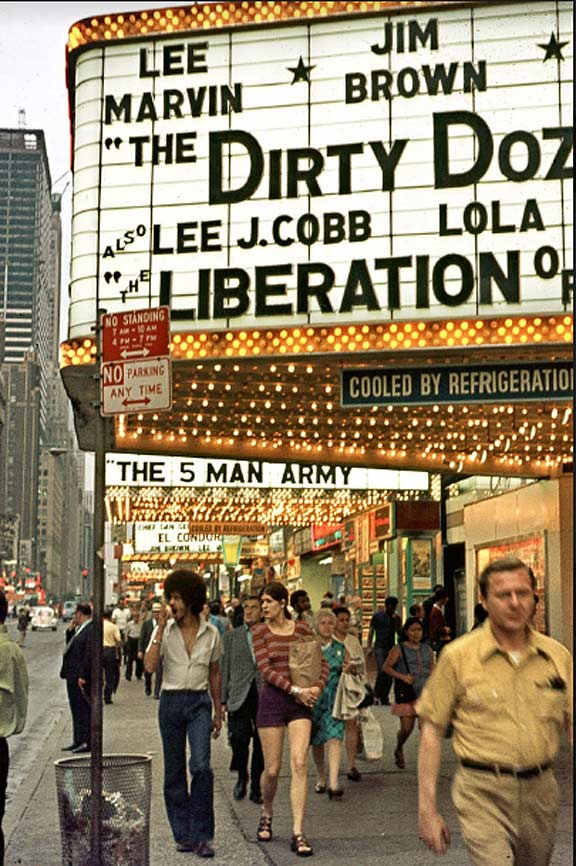
This is probably on the stretch of West 42nd Street between 7th and 8th Avenues, which in the 1980s devolved into Porno Row, but in the early 70s most of the houses featured “legitimate” pictures, though many were grindhouses featuring thrillers, kung-fu movies or science fiction. Psychotronic Video author Michael Weldon has written of spending hours in these theaters in his formative years.
In the foreground, The Dirty Dozen, first unreeled in 1967, saw a 1970 rerelease on a double bill with the only feature to ever co-star Lee J. Cobb and Lola Falana, The Liberation of L.B. Jones. The 5-Man Army was a spaghetti western helmed by Dario Argento and featuring Peter Graves, the longtime Mr. Phelps of Mission: Impossible.
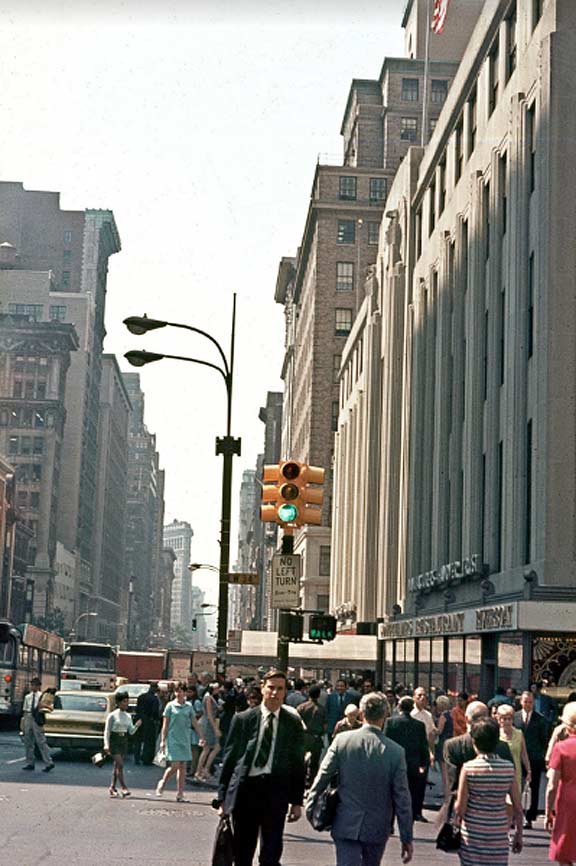
A lunchtime crowd at the SW corner of 5th Avenue and West 34th Street, where the Empire State Building has been in place since 1931, replacing the original Waldorf-Astoria Hotel. 5th Avenue’s trademark twin Deskey posts, installed in 1965, were all still there in 1971; today, all but a handful remain. A pair of General Motors “fishbowl” buses are traveling south–5th Avenue was made a one-way route, going south, in 1966.
Surprisingly, traffic is controlled by a post-top stoplight, again of the Deskey model. Perhaps the lengthy guy-wired stoplights were installed on the other corners. Pedestrian control still used WALK and DONT WALK; they would not be changed to the pictographs the Man and the Hand until the 1990s.
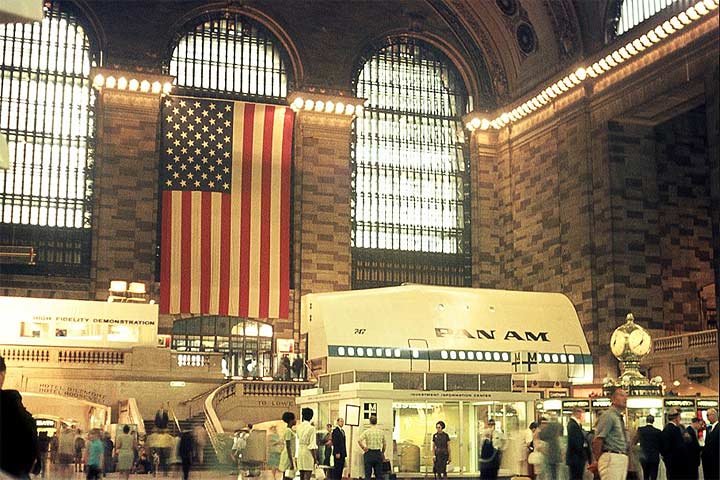
Following the demolished Penn Station before it, Grand Central Terminal cluttered up its grand central hall with information booths, advertising posters and kiosks in the 1960s. The most notable of these was the giant Kodak ad at the other end of the floor. When GCT was renovated in the 1990s, restaurants and retail were retained, but in a somewhat more tasteful manner.
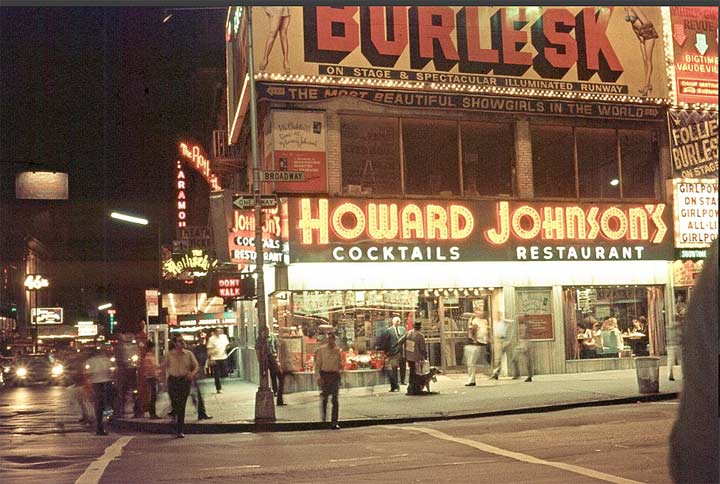
One of the last Howard Johnson’s restaurants held down the NW corner of Broadway and West 46th Streets for a good 4 or 5 decades until it succumbed in 2005. (It was a block away from an artifact that was a good 80 years older — the J.A. Keal’s Carriage Manufactory sign on 47th Street, which has once again been hidden by masonry). The last remaining Howard Johnson’s is in Lake Placid, NY. That restaurant was featured in a 2012 episode of Mad Men.
Above the old HoJo’s were the remains of the old Orpheum Dance Palace (originally Wilson’s Dancing Academy), which entertained customers with “10¢ a dance” more-time-more-money taxi dance partners from 1917 to 1964. Here Henry Miller met June Smith, inspiring him to write Tropic of Capricorn. In the 1970s and 1980s the Orpheum’s 3rd floor was taken over by the New Paris Theatre [described by David Freeland in the NYPress, no longer linked] thusly:
“The establishment’s set-up epitomized Times Square during its peak years of squalor: In between film screenings, a young woman lay on a mattress positioned in the middle of the stage. After a man in a towel entered and the couple had sex, a group of female employees would mill through the audience to solicit patrons for “private showings” in a series of back rooms … Screw illustrator Guy Gonzales recalls the New Paris as the sleaziest of Times Square porn palaces: ‘It smelled like decayed flesh in there, a lot of bodily fluids.’ ”
At length the New Paris closed and the legit whodunit Perfect Crime moved in. But the old Orpheum wasn’t completely de-sleazed, since a string of strip clubs and porn palaces, the last of which was the Gaiety male strip club, occupied the second floor till the very end. The space is now occupied by retail with huge illuminated billboards.
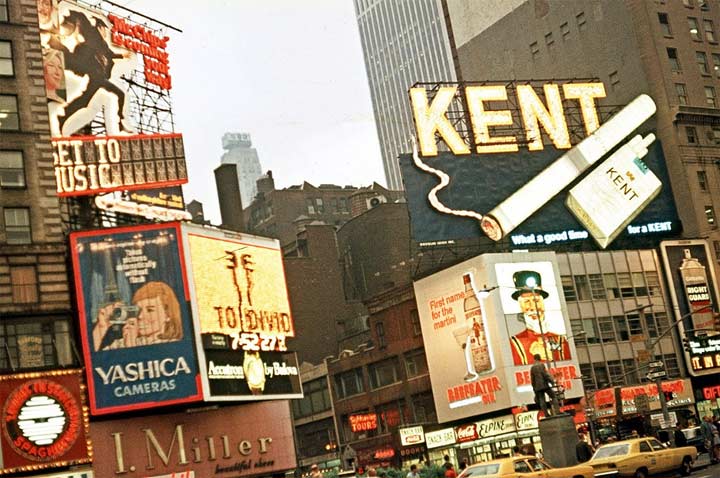
The I. Miller Building, at Times Square and West 46th Street, was built from 1927-1929 and is nearly unrecognizable these days underneath the video billboards and garish scaffolding advertising a chain restaurant. Israel Miller’s shoe store was long patronized by theater people.
But a closer view of the I. Miller Building along West 46th Street will prove to be a glimpse into the Great White Way’s past. In 1927 the I. Miller company took a public vote to determine the most popular theater actresses of the day with the idea of placing their statues on their new 7th Avenue store. The results came in and sculptor Alexander Stirling Calder was chosen to depict them in some of their most famous roles… Ethel Barrymore as Hamlet’s Ophelia, singer-dancer Marilyn Miller as Sunny, Mary Pickford as Little Lord Fauntleroy, and soprano Rosa Ponselle as Bellini’s Norma. These works can still be seen around the corner on 46th and indeed, they have been restored in recent years.
At the top is a billboard for the 1969 film revival of Goodbye Mr. Chips, the classic about a beloved British educator and his wife, with Peter O’Toole and Petula Clark.
Times Square, until the 1980s, was a bastion of cigarette and tobacco ads. Camel ads were engineered to issue “smoke rings” made of steam. My mother was not a heavy smoker, but Kent was her brand. It’s a division of R.J Reynolds and was launched in 1952.
The Yeoman Warders, affectionately called Beefeaters, are ceremonial guards at The Tower of London founded in 1485 as actual guards, and continue to wear the Tudor-style uniforms of the period. Londoner James Burrough founded the gin brand in 1863.
Once again, Elpine Drinks holds down the SE corner. Ads for Yashica cameras and Accutron watches can be found at the I. Miller building.
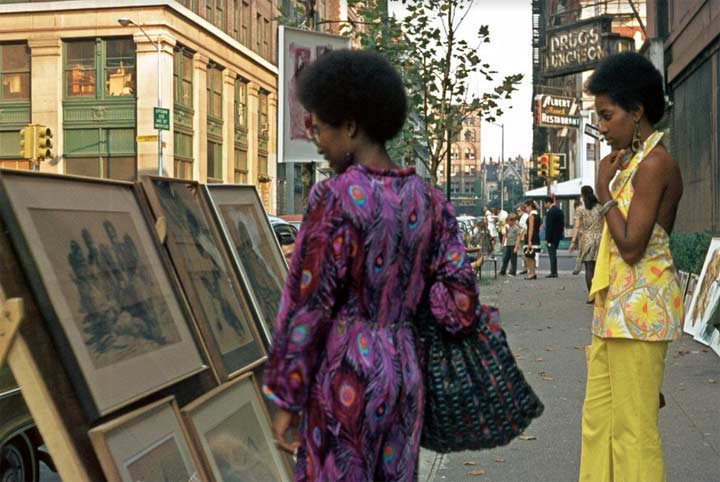
Art enthusiasts look over some paintings for sale at the SW corner of University Place and East 11th Street near Union Square in 1971.
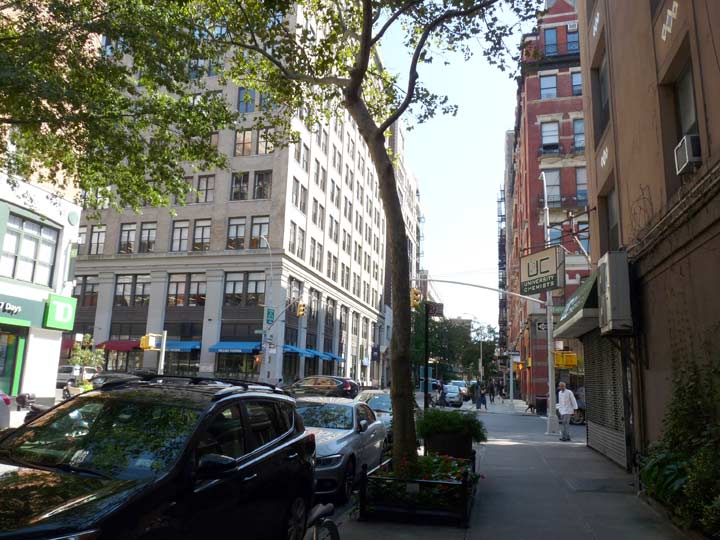
Virtually everything except the artwork remains in place at the same spot in 2018. There is still a drugstore on the corner and its sidewalk sign is still there, but the neon has been replaced. The Albert Restaurant (named for the former hotel on the SE corner) has disappeared.
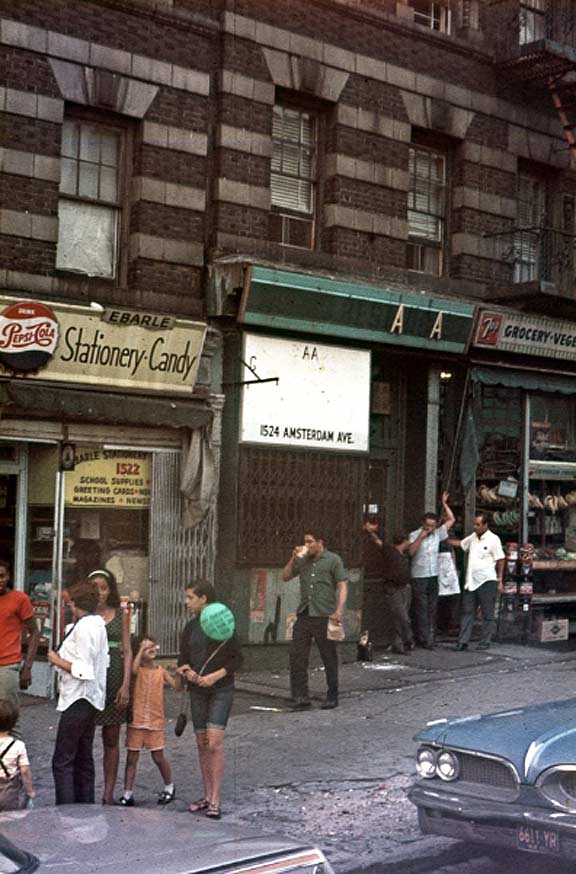
A look uptown at 1524 Amsterdam Avenue near West 135th Street. All of these buildings remain in place, but the storefronts are neater and the sidewalk has been repaired, probably afew times since 1971.
Please help contribute to a new Forgotten NY website
Check out the ForgottenBook, take a look at the gift shop, and as always, “comment…as you see fit.”
9/30/18

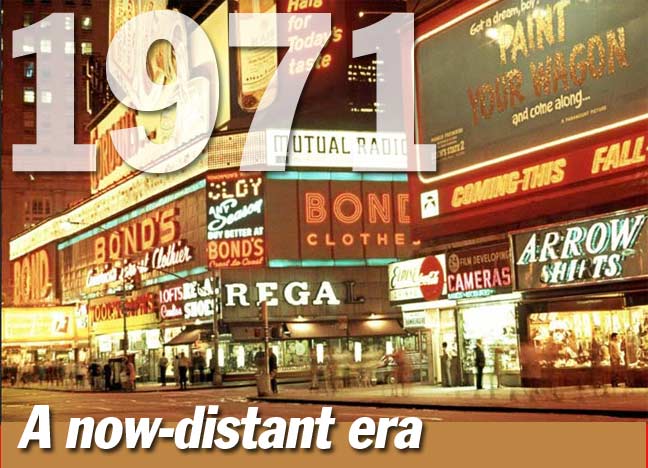
26 comments
I have to admit that back in my younger single days I actually went to one of those Old Times Square live sex show emporiums. Unfortunately, or fortunately, I recall very little of the experience. It must be due to some brain mechanism that blocks out terrible experiences.
Good one Kevin. I’ve been watching The Deuce on HBO and it’s first season was set in 71. By the way I think I’ve been following your blog since about 1997.
And I started it in 1999!
He was reading your mind!
Did anyone else but me noticed two things in that Grand Central photo? They were:
1. The walls were so grimy from dust, dirt and cigarette/cigar/pipe smoke, that they appeared to be a checker board. The dirty appearance, the same as what happened at Pennsylvania Station, gave impetus to destroy GCT – but more sensible thoughts prevailed.
2. A mode of transportation that helped push the NYC (New York Central RR) into extinction, was a big advertiser in the station. That airline was Pan Am, now gone too.
Not only is Pan Am long gone, but the mockup shows a Boeing 747, which was the newest and best type of airliner in 1971 but which today is just barely in production. Boeing makes just a handful each year, mostly as freighters. No US airlines still operate 747’s.
747 is the best. Many engines and an upper deck. I travelled extensively and always felt relieved when I boarded a 747!
Great article and amazing photos.
Your photography Kevin ?
No; see the start of the piece
Here’s another look at the same era. “Taxi Driver” presents a vision of the hell that was NYC pre-Giuliani:
https://www.youtube.com/watch?v=cujiHDeqnHY
Groovy Baby
Wow, it’s like a different city. The lack of crowds in Times Square, the cars/clothes/buses/architecture and signage are all so different that what we see today. As the old saying goes, “NYC will be a great town once they finish building it.”
Pieces like this, with vintage photos and tidbits of info of once-common things which are now long gone; and reminders that help recall those former times, are the sole reason I still check Forgotten-NY.
More! More! More!
Seeing images of the current NYC only makes me sick, and makes me thankful that I’ve been living 1000 miles away for the last 17 years. I had almost given up on this website….but a piece like this makes it all worthwhile!
Thanks!
I was born in Hudson County and grew up mostly in Bergen County. I remember NYC well from back in the 70s and 80s. We remained parishioners at a church in Hell’s Kitchen long after my family moved out of NYC. I don’t know if you really lived in NYC back in those days, but my recollections are certainly very different from yours. Times Square was a porn bazaar. 8th Ave was infested with underage prostitutes. I remember when a business associate of my friend’s father had his car fall through the decking of the West Side Highway. There was blood flowing in the gutters of the meat packing district…some of it from meat. Violent crime was off the scale. Dirt and filth everywhere. Entire sections of the South Bronx looked like Dresden 1945. Poverty was rampant and the human misery that went with it. There are things I don’t like about NYC today, but I don’t miss any of the above.
Re University and 11th: the drugstore went out of business a few months ago. It was a wonder that it lasted so long after the drug chain invasion.
I used to work at Bonds in the mid 60’s, but at the Brooklyn store on Fulton St. It was the hope for many of the salesmen at the time to get promoted to one of the Manhattan stores. Meanwhile, I looked for the Fulton St. Bonds in the mid 90’s and couldn’t find it.
Bonds was where my late father bought most of his suits. I don’t remember If I was ever in any of the NYC stores, but I distinctly remember going to one of their suburban locations. I think there was one at the Garden State Plaza Mall in Paramus? What I remember about Bonds is that the suits came with two pairs of pants, since the pants usually wore out before the jackets did. Yes, people were thrifty back in those days.
These are amazing photos, thank you for posting them. I was 6 years old in 1971 so I don’t remember much, but I do remember the huge cars of the 1960’s that were still around!
Actually, most of the SUVs of today are larger than those old cars, although the SUV’s don’t seem to have as much interior space. New pickup trucks are enormous compared to those back in the day. Compare a 1971 F150 to a new F150 and the new truck looks like a Freightliner.
loved this post. the photo of howard johnson’s was also used by eater for this excellent homage by penn jillette: https://www.eater.com/2015/4/22/8467017/outliving-the-future-at-howard-johnsons
These are absolutely amazing photos and I am so glad you featured them. Was Times Square really so full of ads for smoking and hard liquor? Well obviously it was. There’s much more money now in ads for entertainment. Maybe that’s better. In the “I think we’re looking north on 7th Avenue” photo, the woman on the right in the little black dress was the future, but who knew it?
Great posting. Remember those days well. In 1971 I was a young adult, newly married, living on the Upper West Side and working in Washington Heights. I know that we often bemoan the loss of old, traditional businesses from that era, but the one thing I don’t miss is the rampant street crime that was a citywide problem. Times Square was notoriously bad in those days. That’s why I am glad about today’s much safer city. I can take my grandchildren to see the sights and have little fear.
Ahhh, NYC in the 70s. In 1971, I was a teen from Bergen County NJ and just beginning to explore the city and ride the subway with friends, sans parents. I have no idea how I convinced my parents to let me go. This was the Gritty City back then. Everything was filthy, but the the privilege signs and neon were fantastic!! The paintings displayed on the street brigs me back even earlier – my Dad worked for NYU at 51 West 4th St, across from the “temporary” ANTA theater. I’d go to work with him at least 1 Saturday a month on days when he finished at noon. Since we drove in, we usually parked right there and the artists always had their artwork out on the sidewalk; some used to even lean their work on the parked cars to display them, ours included.
!971 was a good year. After discharge from the Army in August, I started work as a stone derrickman on the Monsanto building, Now the WR Grace building a few blocks from Times Square on 42 street. The pics bring back a lot of memories.
Who’s tops in the convertible line?
Hi! Love your blog and have for years! I think that the photo on the 1971 landing page is actually from 1969. Both Funny Girl and Paint your Wagon were first-run in this photo and could not have been playing for 2 years. Thought you might be interested. Thanks and keep up the wonderful content!